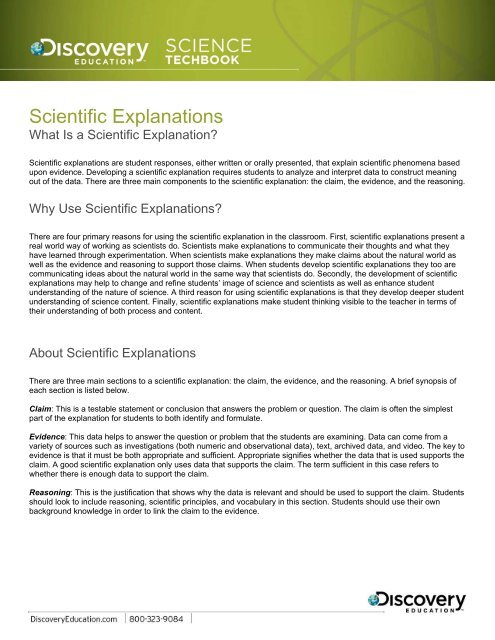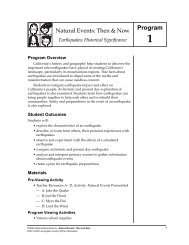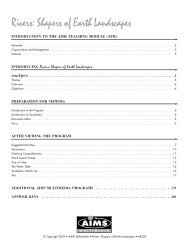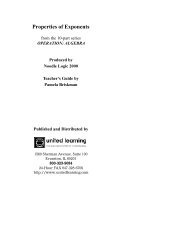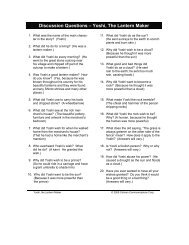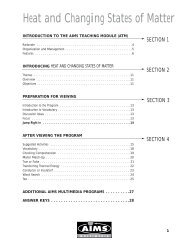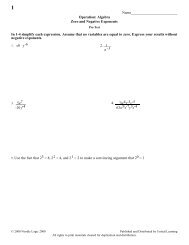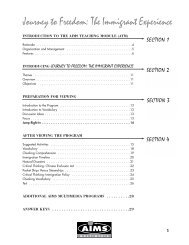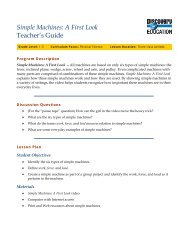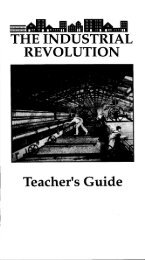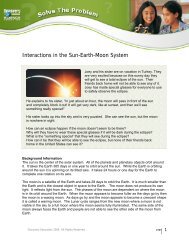Scientific Explanations - Discovery Education
Scientific Explanations - Discovery Education
Scientific Explanations - Discovery Education
You also want an ePaper? Increase the reach of your titles
YUMPU automatically turns print PDFs into web optimized ePapers that Google loves.
<strong>Scientific</strong> <strong>Explanations</strong><br />
What Is a <strong>Scientific</strong> Explanation<br />
<strong>Scientific</strong> explanations are student responses, either written or orally presented, that explain scientific phenomena based<br />
upon evidence. Developing a scientific explanation requires students to analyze and interpret data to construct meaning<br />
out of the data. There are three main components to the scientific explanation: the claim, the evidence, and the reasoning.<br />
Why Use <strong>Scientific</strong> <strong>Explanations</strong><br />
There are four primary reasons for using the scientific explanation in the classroom. First, scientific explanations present a<br />
real world way of working as scientists do. Scientists make explanations to communicate their thoughts and what they<br />
have learned through experimentation. When scientists make explanations they make claims about the natural world as<br />
well as the evidence and reasoning to support those claims. When students develop scientific explanations they too are<br />
communicating ideas about the natural world in the same way that scientists do. Secondly, the development of scientific<br />
explanations may help to change and refine students’ image of science and scientists as well as enhance student<br />
understanding of the nature of science. A third reason for using scientific explanations is that they develop deeper student<br />
understanding of science content. Finally, scientific explanations make student thinking visible to the teacher in terms of<br />
their understanding of both process and content.<br />
About <strong>Scientific</strong> <strong>Explanations</strong><br />
There are three main sections to a scientific explanation: the claim, the evidence, and the reasoning. A brief synopsis of<br />
each section is listed below.<br />
Claim: This is a testable statement or conclusion that answers the problem or question. The claim is often the simplest<br />
part of the explanation for students to both identify and formulate.<br />
Evidence: This data helps to answer the question or problem that the students are examining. Data can come from a<br />
variety of sources such as investigations (both numeric and observational data), text, archived data, and video. The key to<br />
evidence is that it must be both appropriate and sufficient. Appropriate signifies whether the data that is used supports the<br />
claim. A good scientific explanation only uses data that supports the claim. The term sufficient in this case refers to<br />
whether there is enough data to support the claim.<br />
Reasoning: This is the justification that shows why the data is relevant and should be used to support the claim. Students<br />
should look to include reasoning, scientific principles, and vocabulary in this section. Students should use their own<br />
background knowledge in order to link the claim to the evidence.
Teaching <strong>Scientific</strong> <strong>Explanations</strong><br />
As mentioned above, scientific explanations involve students working and acting as real scientists. As a part of this<br />
process the explanation centers on a question or problem that must be answered. The most common time for students to<br />
develop scientific explanations is during the Explain phase of the 5E Instructional Model.<br />
The questions that students answer can arise from a variety of different places. Teachers are encouraged to help students<br />
develop their own questions (guided inquiry), but it is sometimes useful for teachers to provide the questions to students<br />
(directed inquiry). A good starting place for teachers to find questions for students to answer is in each model lesson.<br />
Assign groups a specific essential question and then have students share their explanation with the class.<br />
After students have a question to answer (they have either been provided a question or they have developed their own),<br />
they should seek out data (evidence) that answers that question. Data can come from investigations (numeric and/or<br />
observational), text, and video. Data is this case is simply information that helps to answer the question. Students should<br />
be reminded during this time that the data should be appropriate and sufficient to answer the claim.<br />
Misconception Alert: It is often believed that students should formulate a claim before they obtain data. This is<br />
grounded in the belief that the claim is similar to a hypothesis. During a <strong>Scientific</strong> Explanation students are not<br />
formulating a hypothesis; instead they are organizing their thoughts around a specific question or problem by<br />
examining data, interpreting data, and applying reasoning and scientific principles and vocabulary.<br />
After collecting the data students should make a claim. The claim is an assertion or conclusion that answers the question<br />
that the student in examining. The claim should explain how the data relates to the question or problem. Finally, students<br />
should formulate the <strong>Scientific</strong> Explanation. Students should provide a justification that uses reasoning to link their claim<br />
to the evidence that they found. Included in this justification should be the reasons that the data is relevant to the question<br />
or problem, a description of how the data can be used to support the claim and appropriate scientific principles and<br />
vocabulary.<br />
Instructional Hint: To make this process a bit easier for students to see, try explaining it to them in this manner:<br />
Explanation = Claim + Evidence + Reasoning. Viewing it in this manner provides students a clearer path to write<br />
the explanation. Help students understand that when they write a scientific explanation they should restate their<br />
claim and then use reasoning, scientific principles, and vocabulary to link the evidence to the claim that they had<br />
made.<br />
Supporting the Construction of <strong>Scientific</strong> <strong>Explanations</strong><br />
There are several instructional items that teachers should keep in mind when helping students construct scientific<br />
explanations.<br />
1. Teachers should make the framework for creating a scientific explanation explicit. Teachers should be sure that<br />
students have a deep understanding of the three components of the scientific explanation: the claim, the<br />
evidence, and the explanation. The student version of the scientific explanation provides this framework for<br />
students.<br />
2. Teacher should discuss the rationale behind scientific explanations. Students should not only know what a<br />
scientific explanation is, but also why they are used. Teachers also have the opportunity here to explain that a<br />
claim unto itself is not convincing or persuasive. Instead, providing evidence and reasoning creates a stronger<br />
case for a claim.
3. Teachers should model the construction of scientific explanations. After introducing scientific explanations, the<br />
teacher should model the construction of a scientific explanation as well as the though process behind the<br />
creation. When modeling this process, teachers should not only model the writing process but also talk through<br />
the thinking process with students. This helps to build metacognition in students and provides them insight to how<br />
scientists think.<br />
4. Teachers should discuss the similarities and differences between everyday explanations and scientific<br />
explanations. Teachers should point out that in everyday life people try to convince others of claims that they<br />
make. Teachers can point this out through the use of musicians and athletes in the advertising industry. Teachers<br />
can show how claims that these people make can use evidence and reasoning. It is important to note here that<br />
although scientific explanations and everyday explanations can look similar they generally are not.<br />
5. Teachers should provide multiple opportunities for students to construct explanations. These opportunities should<br />
include scientific explanations developed from investigations (Virtual Labs, Hands-On Activities, and Hands-On<br />
Labs), as well as using the text and video to answer the essential questions in a given model lesson (reading<br />
comprehension). These various opportunities allow for the scientific explanation to be used as a check for<br />
understanding.<br />
6. Teachers should provide opportunities for students to critique other explanations through the peer review process.<br />
When teachers lead their classes through this process they should remind students to focus on the strengths and<br />
weaknesses of others observations. Students should provide each other concrete suggestions for improvement.<br />
7. Teachers should provide students with explicit and thorough feedback. Teachers should comment on the<br />
explanation as a whole as well as the individual components: the claim, the evidence, and the explanation. While<br />
explicit feedback is necessary teachers should take this opportunity to coach students on improvements to their<br />
scientific explanations.<br />
Adapted From: Krajcik, Joseph S., and Katherine L. McNeill. "Assessing Middle School Students' Content Knowledge and<br />
<strong>Scientific</strong> Reasoning Through Written <strong>Explanations</strong>." National Science Teachers Association Conference on Science<br />
Assessment. St. Louis. 30 Mar. 2007. Lecture


